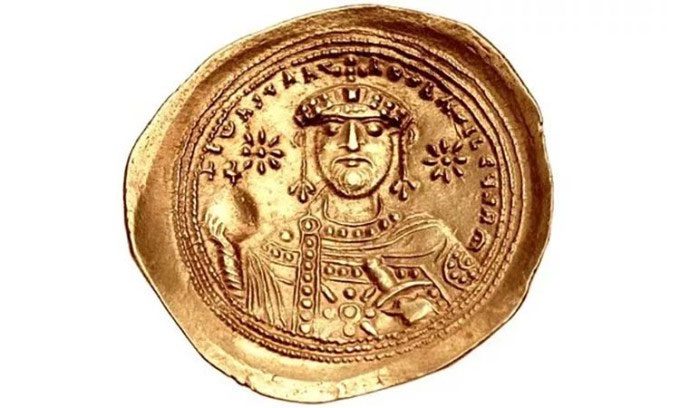The gold coin depicting the portrait of the Eastern Roman Emperor with two stars around his head may reference the supernova explosion of 1054.
In 1054, a star exhausted its fuel and exploded in a brilliant supernova. Despite being 6,500 light-years away, the explosion was visible in the Earth’s sky for 23 days and several hundred nights thereafter. This explosion is now known as SN 1054 and can still be observed in the Crab Nebula, although a good telescope is required.

One of the two stars near the emperor’s head may be a supernova. (Photo: cngcoins/Filipovic).
SN 1054 was so bright that Chinese astronomers referred to it as “Guest Star” – a term for a star that suddenly appears where none existed before and then becomes invisible after a period. Observers in Japan, Iraq, and possibly the Americas documented the sudden appearance of the explosion in writing and on stone. However, in Europe—where Emperor Constantine IX of the Eastern Roman Empire held significant influence—the great explosion in the sky was never mentioned.
A recent study published in the European Journal of Science and Theology in August analyzed four Eastern Roman gold coins minted during the reign of Emperor Constantine IX (1042 – 1055). While three coins depict a single star, the fourth coin features two bright stars surrounding the emperor’s head, which may subtly represent the supernova of 1054.
According to the research team, the emperor’s head may symbolize the Sun, the eastern star representing Venus, and the western star representing SN 1054—the supernova that shone for nearly a month in the daytime sky, opposite Venus. The two stars might also represent the Eastern Orthodox and Western Catholic branches of Christianity, which separated during the Great Schism in July 1054.
If this interpretation is correct and the gold coin indeed depicts SN 1054, then Eastern Roman scholars may have been prohibited from studying or mentioning this supernova due to religious issues. The Church may have had philosophical biases against any changes in the night sky, which was believed to be perfect and eternal. Combined with the chaos of the Great Schism at the time, the Church might have deemed it best to ignore the supernova. However, it is likely that an astute scholar found a way to “work around the rules.”
The team also visited several museums to study 36 replicas of the two-star coin and discovered that the size of the western star is inconsistent, seemingly shrinking over time. This may have been intended to represent SN 1054 fading from the sky.
These hypotheses are plausible but still lack clear evidence, the research team noted. The size and arrangement of the stars on the coin could represent something else entirely and merely coincidentally align with the appearance of the supernova. Additionally, without an exact minting date, it is impossible to determine whether they were minted before or after the supernova’s appearance.





















































